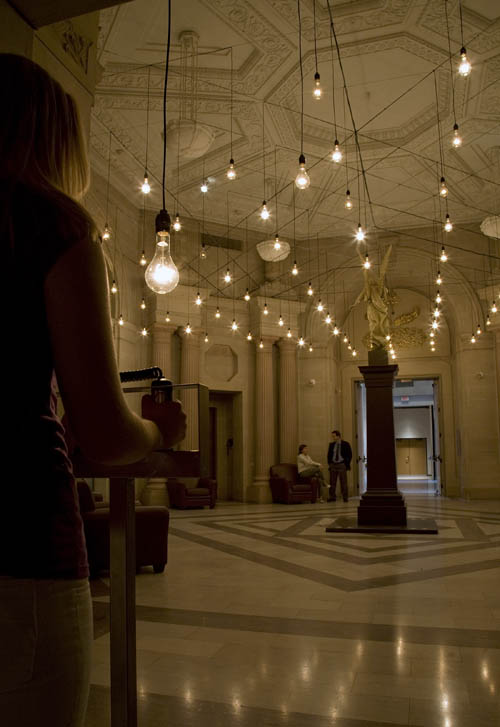A project I’ve been meaning to write about ever since seeing it in Vague Terrain #16 is “Pulse Room” by Rafael Lozano-Hemmer.
 [Image: From “Pulse Room” by Rafael Lozano-Hemmer].
[Image: From “Pulse Room” by Rafael Lozano-Hemmer].
“Pulse Room,” originally produced back in 2006, was an “interactive installation featuring one to three hundred clear incandescent light bulbs,” the brightness of which was controlled by an interface and sensor that could detect “the heart rate of participants.”
When someone holds the interface, a computer detects his or her pulse and immediately sets off the closest bulb to flash at the exact rhythm of his or her heart. The moment the interface is released all the lights turn off briefly and the flashing sequence advances by one position down the queue, to the next bulb in the grid. Each time someone touches the interface a heart pattern is recorded and this is sent to the first bulb in the grid, pushing ahead all the existing recordings. At any given time the installation shows the recordings from the most recent participants.
The room thus becomes a counterpunctual archive of heart rates in space, throbbing like a chandelier in front of you.
 [Image: From “Pulse Room” by Rafael Lozano-Hemmer].
[Image: From “Pulse Room” by Rafael Lozano-Hemmer].
Lozano-Hemmer later expanded this idea in scale quite significantly for his “Pulse Park” project, in which New York’s Madison Square Park was temporarily illuminated by a moving, heart-rate-controlled “matrix of light beams.”
But I would like to see something like “Pulse Subway,” say, where long tunnels flicker off around underground curves as heartbeat-like rhythms of light beat below ground, scaling the whole thing up yet further to form a piece of urban infrastructure (or is that simply a nightclub?); or even “Pulse Cinema,” in which the film itself fades in and flickers out according to the pulmonary ups and downs of the audience. Scenes of high-stress are seamlessly projected, but boring moments make the whole theater drain down toward black. One particularly caffeinated individual keeps the whole place bright as day.
 [Image: From “Pulse Room” by Rafael Lozano-Hemmer].
[Image: From “Pulse Room” by Rafael Lozano-Hemmer].
It’s less the lighting effects that interest me here, though, than the idea of an archive of heart rates, a place where old rhythms could be stored. You could thus try out someone’s pulse—Usain Bolt’s record-shattering runs, or someone who’s survived a car accident—turning the facility (call it the CardiArchive) into a kind of Brainstorm for heart rates. Adventures in tachycardia. Heart-rate sharing.
Upload new pulses into the light-cloud and experience someone else’s panic as your own.
(“Pulse Room” originally spotted via Vague Terrain #16).
The idea of a heart-beat controlled cinema is really funny, and I would love to see some sort of touring exhibit that plays like a 15-30 minute film controlled this way for curious audiences.
I could see the new delinquency at theatres: Groups of teens and frat boys walking in full of energy drinks and caffeine.
Or the opposite side: Groups of meditative experts, Buddhists, and the extremely calm watching with slow, deliberate heart beats.
I love this project. 🙂
See also: artficiel's condemned_bulbes.
French artist Boltanski as been recording for a long time heartbeat and his humanity heartbeat data collection should be (or is it already ?) held at art & architecture island "Naoshima" in Japan.